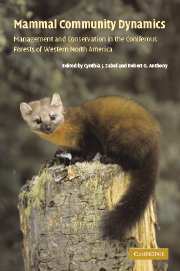 Mammal Community Dynamics
Mammal Community Dynamics Book contents
- Frontmatter
- Contents
- List of contributors
- Foreword
- Acknowledgments
- Part I Management and conservation issues for various taxa
- Part II Community and ecosystem relations
- Part III Conservation issues and strategies
- 16 Small mammals in a landscape mosaic: implications for conservation
- 17 Measuring and interpreting connectivity for mammals in coniferous forests
- 18 An evolutionary and behavioral perspective on dispersal and colonization of mammals in fragmented landscapes
- 19 The functional diversity of mammals in coniferous forests of western North America
- 20 Synopsis and future perspective
- Index
- References
17 - Measuring and interpreting connectivity for mammals in coniferous forests
Published online by Cambridge University Press: 15 December 2009
- Frontmatter
- Contents
- List of contributors
- Foreword
- Acknowledgments
- Part I Management and conservation issues for various taxa
- Part II Community and ecosystem relations
- Part III Conservation issues and strategies
- 16 Small mammals in a landscape mosaic: implications for conservation
- 17 Measuring and interpreting connectivity for mammals in coniferous forests
- 18 An evolutionary and behavioral perspective on dispersal and colonization of mammals in fragmented landscapes
- 19 The functional diversity of mammals in coniferous forests of western North America
- 20 Synopsis and future perspective
- Index
- References
Summary
Introduction
Western coniferous forests have a history of natural disturbance due to fire, disease, and other factors (Agee 1993), but during the past century late-seral forests have been increasingly fragmented due to logging and development. For example, in the Pacific Northwest, less than half of pre-settlement, old-growth Douglas-fir (Pseudotsuga menziesii) forest remains, often in relatively small remnants of 100 ha or less in a matrix of clear-cuts and regenerating forest (Booth 1991, Garmon et al. 1999, Jules et al. 1999). Road building has also impacted wildlife habitat, with an average of 3.4 miles of road per square mile on United States Forest Service roaded-lands and approximately twice that on private lands (Federal Budget Consulting Group and Price-Waterhouse LLP 1997, Coghlan and Sowa 1998, Federal Register 2001, USDA 2001).
For certain species associated with late-seral forests, fragmentation due to human perturbations has two consequences: loss of habitat and changes in connectivity among remnants. Habitat loss, and the concomitant decrease in population size for some wildlife species, has garnered the most attention because such loss is painfully obvious both in its occurrence and its effects. The second consequence, the change in connectivity among populations, is more subtle and harder to measure.
Nevertheless, the importance of populations being connected versus isolated has been underscored in the scientific literature for at least 70 years. For example, biologists have long recognized that the interplay between population size, local adaptation, and gene flow (connectivity) will create a unique genetic structure across a landscape (Wright 1931).
- Type
- Chapter
- Information
- Mammal Community DynamicsManagement and Conservation in the Coniferous Forests of Western North America, pp. 587 - 613Publisher: Cambridge University PressPrint publication year: 2003
References
- 10
- Cited by


